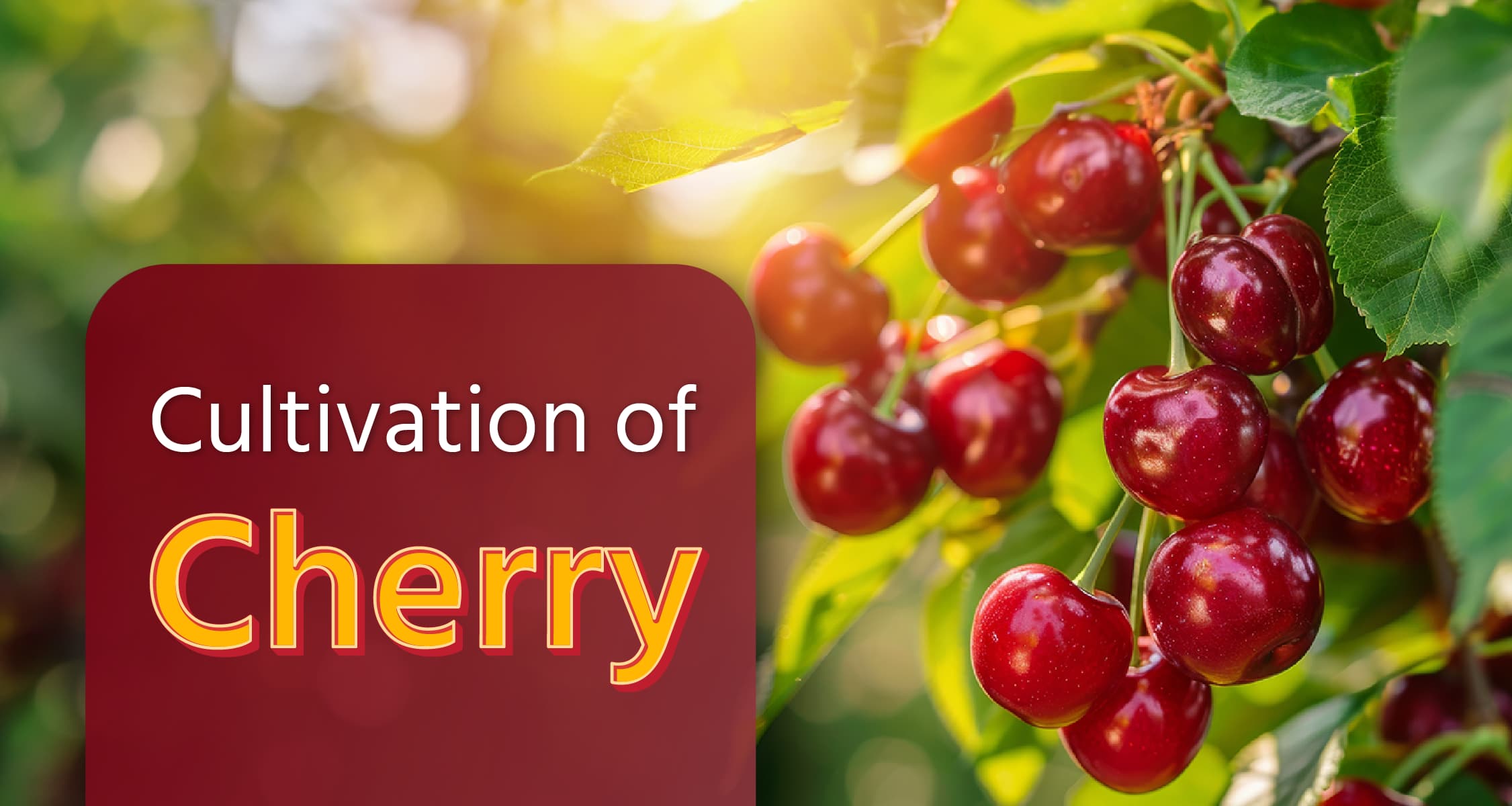Cultivation of Cherry

Cherry is a popular stone fruit known for its sweet and sour taste. This fruit is famous not only for its flavor but also for its health benefits. Cherries are rich in Vitamin A, Vitamin C, Vitamin B6, manganese, iron, copper, thiamine, niacin, and phosphorus. Additionally, cherries contain a high amount of antioxidants, which are beneficial for health. In this article, we will discuss various aspects of cherry cultivation, including climate, soil, sowing, fertilization, irrigation, and disease and pest management.
How to Cultivate Cherry?
Climate
- Cherry cultivation requires a cold climate. To bear fruit, the trees need a temperature range between 15°C and 25°C. For flowering, cherry trees need a winter dormancy period with temperatures below 7°C. Therefore, cherry cultivation is done in areas where winters are cold and long.
Soil
- Cherry cultivation requires fertile soil with good drainage. The ideal soil pH should be between 6.0 and 7.0. The soil should be rich in organic matter. Sandy loam soil is considered the most suitable for cherries. Excessively waterlogged or overly sandy soil can affect the cherry tree.
Sowing Time
- Cherry trees can be propagated by grafting onto rootstocks. The ideal time for planting is during the winter months, from December to February. Cherry plants can be planted during the winter from February to March or from October to December.
Improved Varieties
There are several improved varieties available for cherry cultivation in India:
- Early-maturing varieties: Early, Elton Heart, Black Heart
- Mid-season maturing varieties: Prolific Bedford, Waterloo
- Late-maturing varieties: Emperor Francis, Governor Wood
Planting
- Preparing seedlings from seeds
Cherry plants can be grown from seeds. The seeds must be fully ripe, soaked for a day using a special method, and stored in a cool, dry place. The seeds require cold treatment for germination. Soak the seeds in a cool, dry place for 24 hours. The seeds are sown in February, June, and September.
- Grafting method
Cherry plants can also be prepared by grafting onto rootstocks. After planting, the plants need to be supported with wooden stakes. The cherry trunk should be protected from direct sunlight. Applying a lime wash or covering it with a cardboard strip will be beneficial.
Planting method
- When cherry plants are about 46 cm (18 inches) tall, they are ready for field planting. Plant them in beds 6 inches high and 45-50 inches wide, with a spacing of 18 inches between the prepared beds. Maintain a row-to-row distance of 6 to 10 inches and a plant-to-plant distance of 1 inch.
- The planting should be done in cool weather. To plant approximately 200 plants per acre, a spacing of 4.5 meters x 4.5 meters is required.
Irrigation Management
- Cherries require minimal irrigation because they mature quickly. Therefore, they can be grown in dry climates. However, mulch can be used to retain moisture. Sour cherry varieties need even less water.
Fertilizer Management
- Cherry plants need more nitrogen compared to other plants. It is essential to provide adequate amounts of phosphorus and potash to promote healthy growth and fruit production. The amount of fertilizer used for apple crops is similarly used for cherry plants, while sour cherries require more nitrogen. Each plant needs 217 grams of urea, 600 grams of DAP (Di-ammonium Phosphate), and 430 grams of MOP (Muriate of Potash).
Diseases and their prevention
- Cherry plants can be affected by various diseases and pest problems. To prevent bacterial gummosis, spray Bordeaux mixture in the fall and spring. Leaf spot causes purple spots on leaves, which dry up and create holes. Brown spot occurs during fruit harvest, especially in sweet and Duke varieties, forming brown spots on rotting parts. Blackfly is found on new leaves and branches, exuding a honey-like substance that damages the fruit.
Intercropping
- Suitable intercrops for cherry farming in India include legumes such as peas and beans, as well as leafy vegetables like spinach and lettuce.
Harvesting
- Cherry plants start bearing fruit 5 years after transplanting and provide good yields for up to 10 years. If the tree is properly managed, fruit production can be achieved for up to 50 years. The fruit begins to ripen in mid-May. Bing and Black Heart varieties have fewer issues with fruit cracking. Cherries are harvested when they are fully mature, usually from late May to early June.
Yield
- Approximately 15-25 kg of fruit is produced per tree. The fruit should be harvested before it ripens completely, as it can spoil quickly after ripening. Sweet cherries are consumed fresh, while sour cherries are used for salads, preserves, or canning.
Benefits of Cherries
- Cherries contain various nutrients such as vitamins A, B, C, thiamine, copper, antioxidants, water, iron, niacin, manganese, riboflavin, potassium, fiber, quercetin, phosphorus, beta-carotene, and more. Eating at least 8 cherries daily can reduce the risk of heart-related diseases, improve sleep, aid in weight loss, boost energy levels, support digestion, and help prevent the growth of cancer tissues.
Do you also want to cultivate cherries? If yes, let us know in the comments. For more interesting and important information, follow the 'Horticulture' channel now. If you liked this post, like it and share it with your farmer friends for more reach.
Frequently Asked Questions (FAQs)
Q: How long does it take for a cherry plant to bear fruit?
A: Cherry plants start bearing fruit 5 years after planting and provide good yields for up to 10 years. With proper care, trees can bear fruit for up to 50 years. The fruit begins to ripen in mid-May, and varieties like Bing and Black Heart have fewer cracking issues. Harvesting is done from late May to early June when the fruit is fully mature.
Q: When are cherries planted?
A: Cherry trees are not planted from seeds; instead, they are grown by grafting or budding on rootstocks. The best time to plant them is in autumn (October-November) and spring (February-March). These seasons provide mild and favorable weather conditions for the growth and development of the plants.
Q: Where is cherry cultivation done?
A: Cherry cultivation is primarily done in the northern states of Jammu and Kashmir, Himachal Pradesh, and Uttarakhand. The suitable climate and topography of these states are favorable for cherry farming.
कृपया सुरू ठेवण्यासाठी लॉगिन करा

Get free advice from a crop doctor
